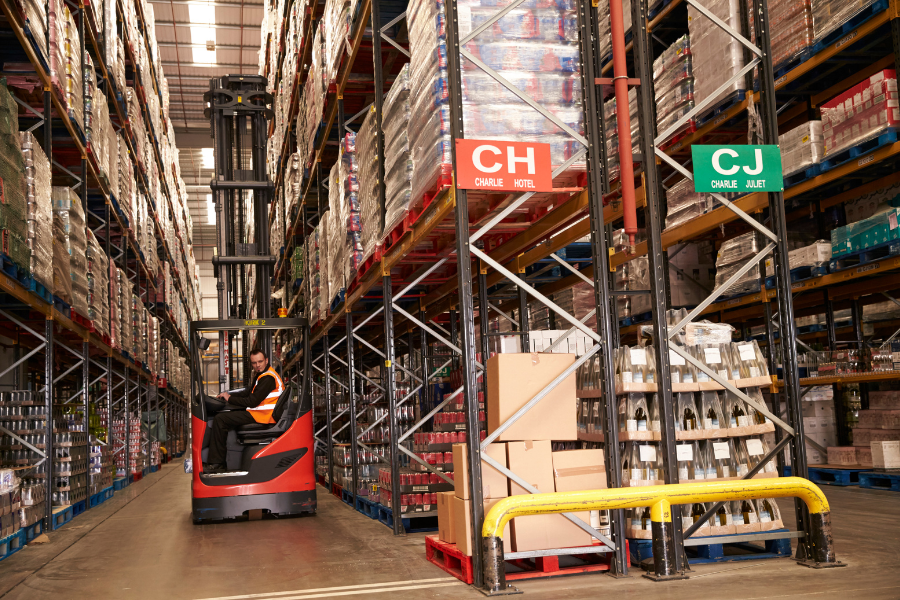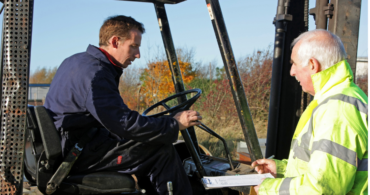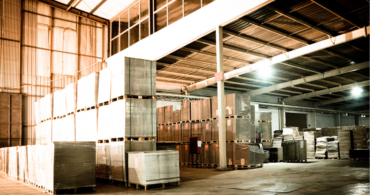In this corner, weighing on average 3,000-5,000 pounds, the thriller from Caterpillar (and Toyota, Mitsubishi, etc.): the forklift. In the opposite corner, the tiny truck that hits great heights: the reach truck forklift.
Welcome to the second article in our no-holds-barred series comparing the lifting machines we all love. The first epic duel occurred during the battle of the telehandler vs forklift, and today we’re turning our attention to the reach truck vs forklift fight.
Alright, the machines have bumped masts and returned to their corners. We’re ready to begin.
Round 1 Reach truck vs forklift: What are they?
What is a forklift?
This seemingly straightforward question is a little more complicated than it first appears. Nearly everyone can picture a counterbalanced forklift, the zippy truck that zooms around warehouses moving and lifting cargo. However, there are actually seven classifications of forklifts, and a reach truck forklift falls under one of those classifications.
So, the actual answer to “What is a forklift?” is extensive and ranges from the nimble trucks we’re describing today to the giant beasts that operate outdoors. For this article, “forklift” refers to the standard counterbalanced lift.
Counterbalanced forklifts typically have four wheels (although some have three) that are usually cushion (solid), although some have pneumatic (air-filled) tires. The vehicle’s most prominent feature is the forks attached to the truck’s mast.
What is a reach forklift?
As e-commerce continues to dominate, more and more warehouses and distribution centers are necessary to ensure those “next-day delivery” promises are kept. Additionally, these spaces are asked to store more inventory than ever before. Since the physical warehouse space cannot change (without considerable cost), the solution is to narrow the aisles and raise the racks. However, those narrow, tall aisles also need a machine capable of navigating lanes and reaching the heights. Enter the reach lift forklift.
A reach truck forklift is quickly becoming the most popular warehouse vehicle because the machine can fit in aisles that would cause a counterbalanced lift to slam into the racks, which in a movie, would result in a comical domino effect. However, in real life, it would lead to thousands of dollars in damage and several potentially serious injuries.
A reach truck forklift has forks attached to a mast at the front of the truck but a much smaller body than a counterbalanced forklift. As a result, the reach truck operator either sits sideways or stands (in a stand-up forklift reach truck, the operator either faces forward or parallel to the direction of travel, depending on the machine’s design). A forklift reach truck commonly has two large rear wheels and two or four smaller front wheels nestled inside the base legs that extend from the front of the vehicle.
Round 2 Lift truck vs forklift: How do they work?
How does a counterbalanced forklift work?
Counterbalanced lift trucks have forks attached to a vertical mast, allowing them to lift and move heavy loads. In some instances, the mast can tilt slightly forward and backward. Most counterbalanced forklifts have a maximum reach of 10-15 feet.
The term “counterbalanced” refers to the heavy battery that powers the truck and additional counterweights in the vehicle’s rear that keep the truck level while lifting and moving. The lift truck’s three-point suspension system also helps to distribute the weight.
How does a reach forklift truck work?
A reach truck forklift is not a counterbalanced vehicle. Instead of using heavy rear weights, a reach forklift truck has two outer base legs that stabilize the vehicle and distribute the load’s weight when lifting and placing cargo. The vehicle’s wheelbase is actually the same as a counterbalanced forklift. However, because the body of a reach truck is more compact, the vehicle carries cargo within the wheelbase, which is how it maintains stability when moving.
Because the operator’s view is frequently obstructed or they are facing sideways, many vehicles have features to help improve the driver’s view. For example, some reach trucks have an overhead camera that enables the operator to navigate and operate the lift while watching a screen. Other machines have cabs that tilt or open canopies.
On average, a reach lift forklift cannot handle as much weight as its counterbalanced counterparts. However, their advantage is the highs they can hit. Most reach trucks have masts that can raise cargo 30-35 feet, and some models can exceed 40 feet.
Typically, reach trucks have either a moving mast or a pantograph reach mast. A pantograph mast uses a hydraulic scissor reach mechanism to extend the forks into the racks. To store cargo, these trucks drive as close as possible to the frames (the truck’s base legs actually extend into the racks) and then activate the scissor mechanism. So, these racks cannot have a bottom shelf. Instead, the lowest pallets are stored on the floor.
A moving mast is pretty much what the name implies. Instead of using a scissor mechanism to reach into the racks, the entire mast on these trucks literally moves forward to place cargo. Because these trucks do not need to drive into the racks, they may have the same large wheels on the front as the back.
Round 3 Reach fork truck vs forklift: Where do they work?
Where do counterbalanced forklifts operate?
The three-point suspensions, rear-wheel steering and cushion tires of most counterbalanced forklifts are intended for the smooth, paved surfaces of warehouse docks and floors. Uneven surfaces and rough terrains are not friends to these vehicles. As such, most counterbalanced forklifts are used indoors to move cargo in and out of 18-wheelers and storage racks.
However, counterbalanced forklifts are incredibly versatile machines. They can use various attachments (to carry barrels, lumber, etc.) and safely lift thousands of pounds (always check a forklift’s data plate to confirm the vehicle’s maximum carrying capacity).
Counterbalanced forklifts have long bodies, partly due to the counterweights at the back of the truck. This means that counterbalanced forklifts have a wide turning radius and usually need 11-13 feet of aisle space to maneuver.
Where does a forklift reach truck operate?
As noted, most reach trucks roam similar terrain as a counterbalanced forklift (the existence of an outdoor capable reach truck is relatively new). However, the layouts they can navigate are quite different.
A reach lift forklift is compact and designed for the tight turns and narrow aisles of modern warehouses and distribution centers. Due to their compact size, reach trucks can handle much smaller aisles, typically eight or nine feet of aisle space, and reach approximately 20 feet higher than most counterbalanced forklifts. Also, some specialty reach trucks can move laterally down aisles, reducing their footprint and the necessary aisle width.
Ultimately, in the great reach truck vs forklift debate, whether someone needs a counterbalanced forklift or a reach truck forklift comes down to why and where they need the machine. Will they carry heavy cargo and travel in a space with wide aisles? Then a counterbalanced forklift is likely the best solution. However, if they need to navigate narrow aisles and racks that extend into the clouds, then a reach forklift is likely the best machine.
For all forklift repair and maintenance needs, whether counterbalanced forklifts or reach trucks, Texas Motive Solutions is always ready to help. Please give us a call at (888) 316-2459 or fill out this form to begin a service request and discover everything we can do for you.


